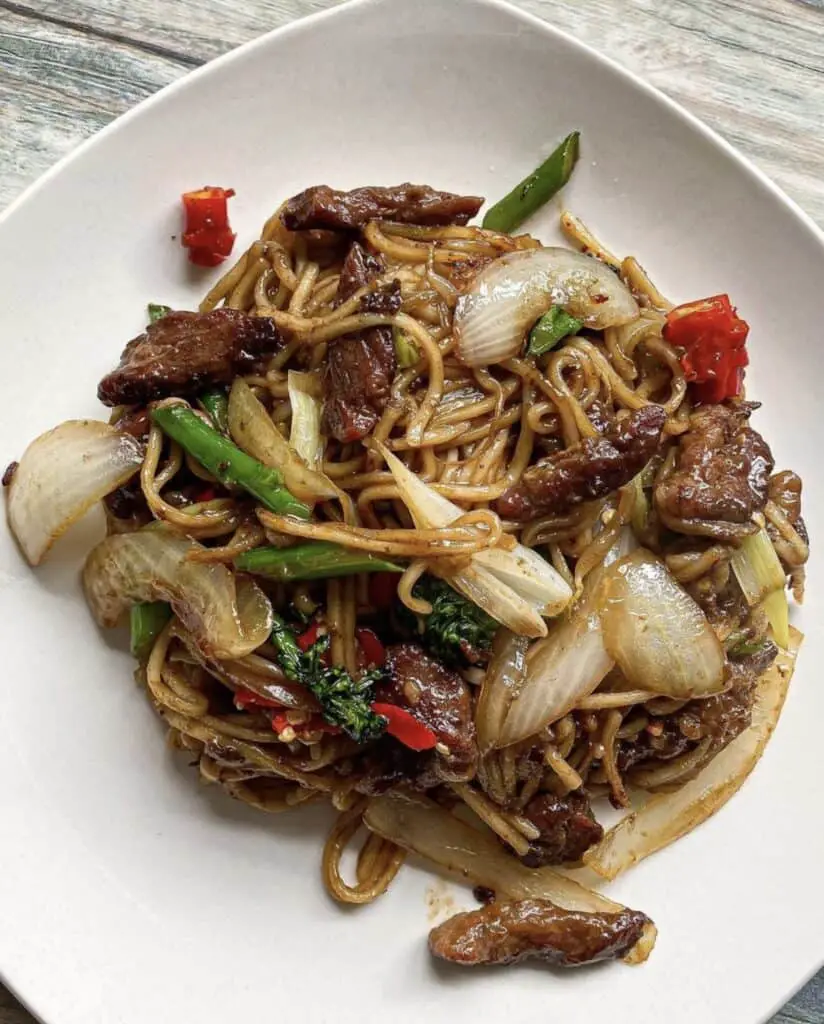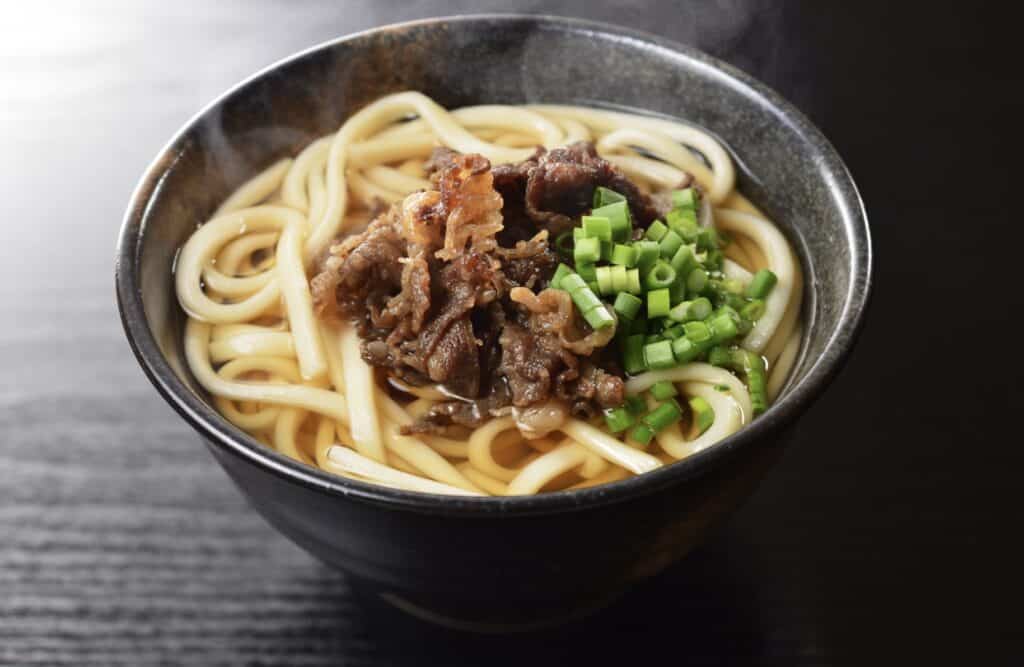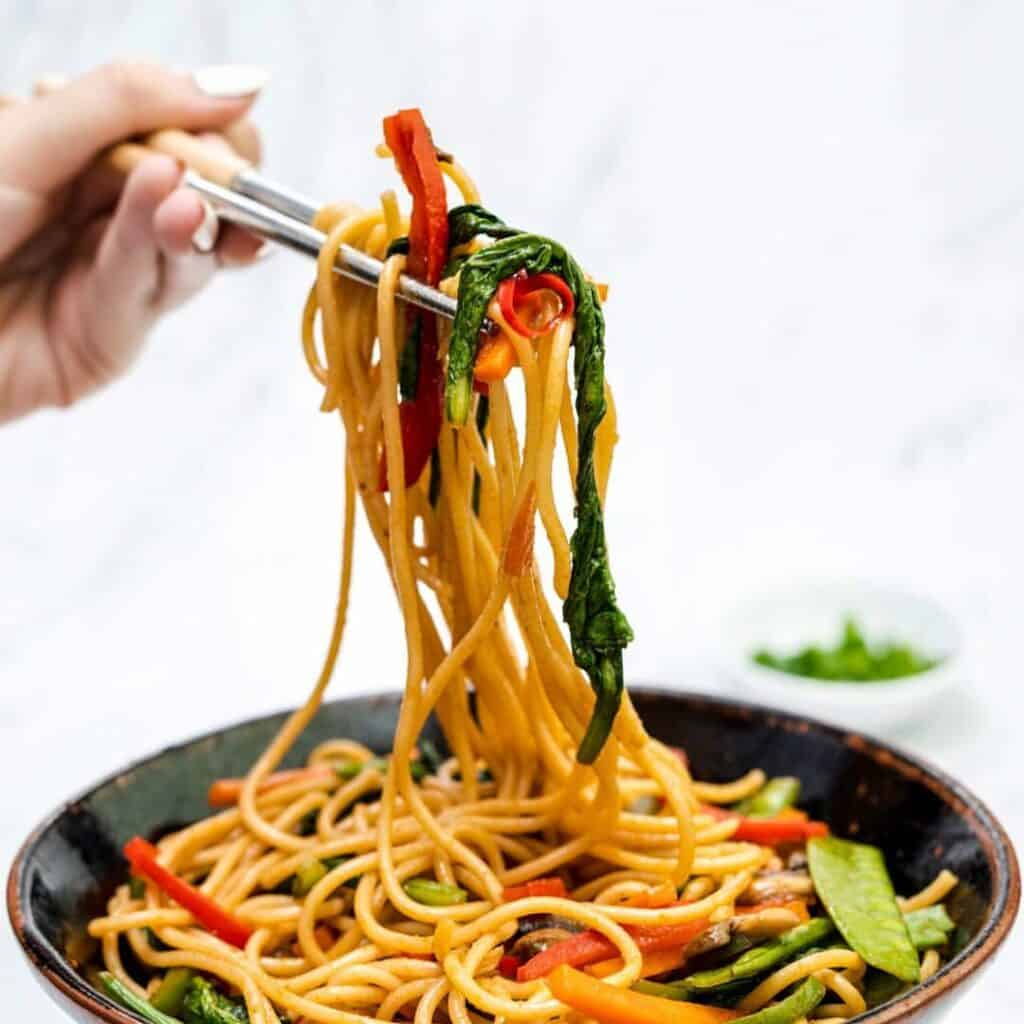If you enjoy Asian cuisine, then you’ve almost certainly enjoyed a warm bowl of noodles or soup made from either lo mein or udon noodles. Both types of noodles are known for being thick, bouncy noodles that provide a wonderful, chewy texture that you can’t go wrong with. Despite their similar texture and appearance, however, a couple of key differences set these two noodles apart from each other.
The main difference between lo mein and udon noodles is that lo mein noodles are made with eggs. Although both lo mein and udon noodles use a wheat flower as the common base, the extra egg used to make lo mein results in a slightly chewier texture that’s great for pasta-like dishes such as shrimp lo mein or beef lo mein.


Udon noodles absorb more broth and are more commonly added to soup-like dishes such as Japanese nabemono.
When it comes to noodles, it’s all about the texture, and it’s the same with udon vs. lo mein. Certain noodles are better in soups, while others can be eaten on a plate without broth. Some noodles taste better with meat, while others taste better with vegetables.
In today’s article, I’m going to break down some of the most common differences between udon noodles vs. lo mein and discuss their various uses in Chinese and Japanese cuisine.
If you’re looking for a recommendation, I recommend Matsuda Udon Noodles and Simply Asia Chinese Style Lo Mein Noodles.
The Difference Between Lo Mein And Udon Noodles
As I mentioned, both noodles use a wheat flour base to create a thick noodle that’s quite different from Ramen (which tends to be a lot skinnier). However, lo mein adds eggs to the noodle mixture, resulting in a thicker noodle that’s not quite as soft as an udon noodle. That’s why the comparison comes down to udon noodles vs. egg noodles.
Another key difference between lo mein and udon noodles is their country of origin. Lo mein originated in China, while udon is a Japanese style of noodle. Despite this difference, however, there’s a lot of overlap between dishes, and it’s common to see Chinese noodles in Japanese cuisine and vice versa. You can typically find both types of noodles in your local Asian supermarket.
So, now that you know the fundamental differences between these two famous Asian noodles, let’s take a more in-depth look at these two noodles and what makes them unique compared to other noodles.
What Are Udon Noodles?

Udon noodles are probably the most common form of noodles found in Japan. They’re widely regarded as a “comfort food” and are extremely popular in Japan’s southern regions between Osaka and Kyushu. Most food historians agree that udon noodles originated in the Tang dynasty around the year 620 C.E.
Traditionally, the dough used to create udon noodles is known for being very thick and hard. Before modern machinery made noodle production faster and easier, artisan noodle makers would often have to stomp on the dough with their bare feet to soften it enough to create the soft, chewy texture udon is known for. Udon noodles are typically 3 to 4 millimeters thick, making them a lot thicker than ramen and other types of Italian noodles that most people are more familiar with.
What Are Lo Mein Noodles?

Technically speaking, lo mein is a dish that’s made using egg noodles. However, many people just refer to them as lo mein noodles since that’s the most common dish made with egg noodles. Lo mein noodles typically have a yellow tint to them due to the added egg yolk.
Historians believe that China was the first country to create the egg noodle and believe that the food originated sometime around the year 200 C.E. (almost 400 years prior to the creation of the Japanese udon noodle). However, a recent archaeological find revealed a 4,000-year-old strip of egg noodle that was found in China, indicating that noodle-making goes back far longer than previously thought.
Like udon noodles, egg noodles start with a thick wheat flour base that’s mixed with eggs to create a more chewy consistency. The dough is hard and must be repeatedly rolled to soften the fibers to create the classic taste.
Taste Difference Between Udon and Lo Mein Noodles
Although they may look and feel similar, there’s a considerable taste difference between the two noodles. Udon noodles have a taste that’s similar to ramen or certain types of Italian noodles. This is because udon is created using a very simple wheat flour and water recipe. The main use of udon noodles is to absorb broth- that’s how they become flavored. This means that udon noodles have a somewhat bland taste before they’re added to a meal.
Lo mein noodles, on the other hand, have a lot more flavor when eaten plain. Since they’re made with egg, they don’t absorb quite as much broth or flavor as an udon noodle. For this reason, they’re usually served as a standalone dish that’s mixed with meat or vegetables.
Which Noodle Is Healthier For You?
If you’re a health-conscious individual, then you’re probably wondering which noodle is healthier for you. Just looking at the ingredients, egg noodles have more nutritional value than udon noodles. The added egg means that the resulting noodle has a higher protein and fat content, making it more nutritionally dense.
However, just because the noodle itself is “healthier” per-se doesn’t mean that it’s always a healthier choice. For example, most lo mein dishes tend to be cooked in oil and have very high sodium and fat content. Conversely, most udon noodle dishes are made in a water-based broth using lots of healthy vegetables, although some people prefer to eat stir-fried udon. The way that the noodles are prepared is everything.
Lo Mein Noodles vs. Udon When Stir-Fried
That being said, if you’re in need of some stir-fried Asian dish, which is better in the debate between yaki udon vs. lo mein? While both these dishes are made using the stir-fry technique, they will differ in taste and texture. Yaki udon (or stir-fried udon) will deliver a pot of chewy thick and bouncy noodles, that are richly smothered in a tangy and savory sauce. Lo mein is usually made in a salty and savory sauce, using chow mein or wanton noodles.
Does One Have Fewer Carbs Than The Other?
Although egg noodles have a slightly higher protein and fat content than udon noodles, they both share the same number of carbohydrates due to the wheat flour used to make them. If you’re looking for a low-carb noodle alternative, then you might consider trying vegetable-based shirataki noodles!
Egg Noodles vs. Udon – Who Wins?
Different Asian cultures have different cuisines, yet they all have their appeal. But in debates about whether you should make meals with udon vs. egg noodles or perhaps use ramen instead, there isn’t one universal answer. In most cases, to get the right taste, you will have to use the noodles written in the recipe. However, if you don’t have the right ones at home, you can substitute them, but not with any ol’ noodles.
Ramen noodles can be used instead of both udon and lo mein. Lo mein isn’t a good substitute for udon, although it’s okay if you go the other way around. However, if a recipe demands ramen, you should listen to the recipe. I know this is a bit too much information, but the end results will not disappoint.